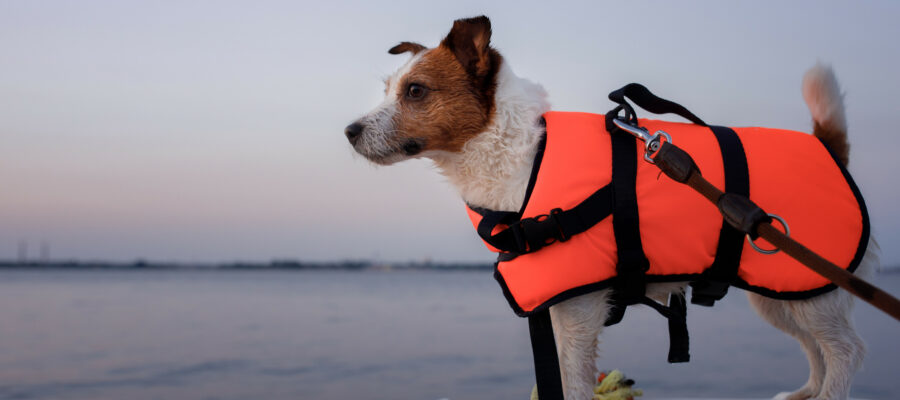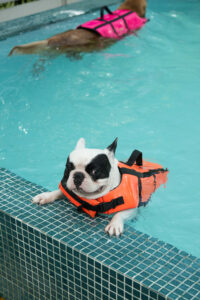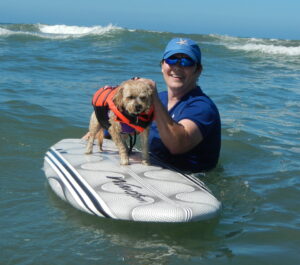Keeping Water Activity Fun and Safe for Your Dog


By Arden Moore – The Pet Health and Safety Coach™
Welcome to the dog days of summer. Are you in search of a destination where your dog can make a splash – literally?
Whether the body of water is an ocean, lake, pool – or even a tub — the health benefits are immense for dogs coping with arthritis, post-surgical recovery, limb problems, or extra pounds. If you have a high-energy dog, swimming is a safer exercise option than walks, runs, or hikes when the heat is on. Quite simply, water therapy is a good aerobic exercise, particularly since the water provides resistance. Water also offers a natural buoyancy, far kinder on dogs than long walks on concrete sidewalks or arduous hikes on rocky terrain. In water, canine joints are not jarred or jolted as they are on land.
A decade ago, my dogs, Chipper and Cleo, were part of a novelty canine group. They were original members of the So Cal Surf Dogs. Seeing dogs of all ages and sizes balance on surfboards and happily ride into shore garnered quite a lot of attention. The phrase, “hanging 10” quickly transformed into proclaiming “hanging 20” as our surf dogs showboated their skills through waves. Fast forward to today. You are seeing more dogs who dig waterplay in boats, canoes, kayaks, and paddleboards. I’m betting that you notice more of them doing the doggy paddle in oceans, lakes, rivers, and pools.
 Set your dog up for success and for safety. First, know your dog. Does he really like swimming or even wading in the kiddie pool in your backyard? Or does he do his best to stay on the boat or race away from the kiddie pool? Many of my dogs have been water lovers, but my current dog, Kona prefers hikes on land to getting her terrier coat wet from a swim. Let me unleash more advice to ensure doing the doggy paddle is safe for your canine:
Set your dog up for success and for safety. First, know your dog. Does he really like swimming or even wading in the kiddie pool in your backyard? Or does he do his best to stay on the boat or race away from the kiddie pool? Many of my dogs have been water lovers, but my current dog, Kona prefers hikes on land to getting her terrier coat wet from a swim. Let me unleash more advice to ensure doing the doggy paddle is safe for your canine:
Book an appointment with your veterinarian first
Have your dog receive a thorough physical exam. Also make sure your dog regularly receives vaccines to protect against giardia and parasites, especially adventures dogs who enjoy hikes and swims.
Recognize that all dogs are not born swimmers
Swimming can be challenging and even dangerous for certain breeds due to their body shapes. Bulldogs, with their barrel chests, pushed-in big faces, and short legs can quickly sink and drown if not fitted with life vests to keep them afloat. Breeds with long backs and short legs, such as Dachshunds and Corgis, also have trouble doing the dog paddle.
Fit all dogs with life vests
Yes, even those love-to-make-a-splash Labradors. Canine vests sport easy-to-grab handles to lift a dog out of the water and they are designed to keep the dog’s head above the water while paddling. I also recommend that you attach a long floating line to the D ring on the vest so you can easily rein in your dog if a strong current suddenly occurs.
Train your dog on land first
Condition your dog to feel at ease in a canoe, kayak, paddleboard, or surfboard on shore before heading into the water. Use treats and positive praise as your dog learns how to go with the movements you make that mimic what will occur in the water.
Evaluate the water source
Rivers, ponds, and lakes can look like fun but they can pose risks. It’s best to avoid rivers with strong currents that can quickly sweep a dog far from shore because he can become fatigued and drown. It’s best to also recommend ponds in community developments or on golf courses because they can contain harmful chemicals from runoff water used to treat lawns and greens. They can also harbor a lot of nasty parasites. When considering if it’s safe for your dog, always avoid lakes with blue-green algae. Your dog can become very sick quickly and even die if he swallows or licks off his coat due to the toxins from algae known as cyanobacteria.
Know when to call it a day
Some dogs are such pleasers that they will continue to swim or fetch tossed balls in the water beyond the point of exhaustion and risk drowning. Limit water activities to 10 minutes or so. Take breaks and provide your dog with fresh water and shade inside a popup doggy cabana. Be on the lookout for signs of exhaustion in your dog: panting heavily, red gums, taking more time to come back to shore, or seeming to sit lower in the water along the shoreline.
Enroll in a pet first aid class
Learn how to perform canine CPR and rescue breathing and what to do if your dog is drowning. As founder of Pet First Aid 4U, I incorporate water safety in our veterinarian-approved classes that feature my dog-cat team of Kona and Casey. Knowing what to do – and what not to do – in a pet emergency when minutes count is truly the best way to be your pet’s best health ally.
Keep skin, coat, and ears clean
Get into the habit of always rinsing your dog off in clean water at the water location. Some dog-welcoming beaches have outdoor showers, but just in case, pack a couple of gallons of water in your vehicle to use to rinse away any parasites, algae, or salt water from your dog’s coat. Be aware that pool chemicals can be drying and harsh on a dog’s skin. After the on-site rinse, I recommend you then treat your dog to a bath at home. I use shampoo and conditioner made by ZYMOX® because they are veterinarian-approved and designed to keep canine coats at their healthy best. Don’t forget the ears. Cleaning your dog’s ears with a gentle cleanser, such as ZYMOX Ear Cleanser, can play a vital role in your pet’s health, especially if your pet is prone to ear infections.
The list may seem long of all the things you need to consider when taking your dog for a swim but the tips provided here will help to ensure that it is a positive experience for you and your dog.


